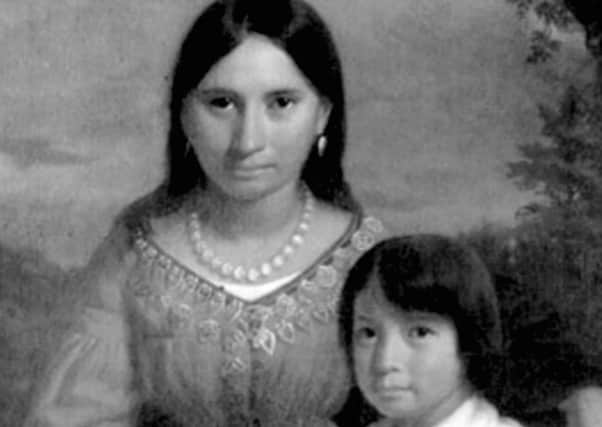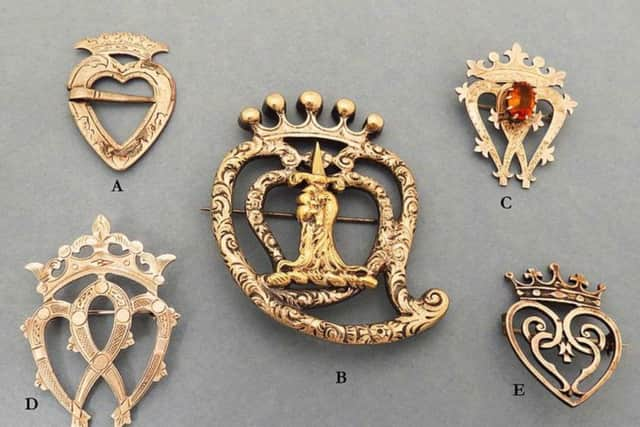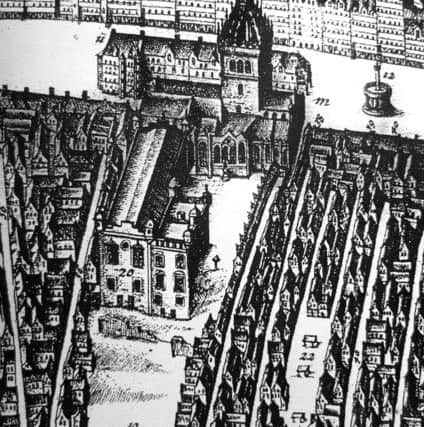The Scottish love token that became a Native American emblem


From the 1600s, the Luckenbooth brooch was a popular treasure among ordinary people of Scotland with the double heart pins named after the row of buildings by St Giles’ Cathedral in Edinburgh where traders and artisans hammered out and hawked their wares.
But it wasn’t just Scots who loved the Luckenbooth. By the mid to late 18th Century, the brooch design had worked its way into Native American decoration and became particularly favoured by the women of the Iroquois, a powerful confederacy of Native American tribes.


Advertisement
Hide AdAdvertisement
Hide AdA portrait of Pocahontas, the famed Native American from Tidewater, Virginia who was captured by the English, was later painted with rows of the brooches around her collar.
The Luckenbooths were first taken to then British North America by Scots fur traders who used the brooches as bartering pieces.
The North West Company, the fur traders founded in Montreal in the late 18th Century with a number of Scots at its helm, was particularly involved in the exchange of “trade silver” with native hunters dealers.


While the Luckenbooths first travelled to Scotland on the clothes of women and children, the brooches were made in bulk by Scottish silversmiths who had too emigrated to then British North America.
Advertisement
Hide AdAdvertisement
Hide AdThe design was picked up by Iroquois silversmiths and ultimately became something of a “national badge”, according to George R Dalgleish, retired keeper of Scottish History and Archaeology at National Museums of Scotland and an expert in Scottish silver jewellery.
Dalgleish gives a definitive account of the Luckenbooth’s cross-cultural journey in A Kingdom of the Mind: How the Scots helped make Canada.
He said: “Many types of silver ornament were traded with Native Americans, particularly medals, gorgets, ring brooches and crosses.


“One type of jewellery found particular favour with Native peoples in the East of the country, namely the heart-shaped brooch.
Advertisement
Hide AdAdvertisement
Hide Ad“So popular were these small brooches with the Iroquois that they style became something of a national badge.
“It is now well accepted that the design of these very distinctive trade-silver brooches originated in Scotland.”
The Luckenbooths were also known as Queen Mary brooches, witches brooch and Johnny Faa’s brooches and were usually given as engagement or marriage gifts.


“My (heart) ye have and thine I crave,” was a typical inscription on the back, Dalgleish noted.
Advertisement
Hide AdAdvertisement
Hide AdWhile the heart was a common symbol in Europe, particularly in heraldry, it was long used to represent love in Scotland.
Dr Joseph Anderson, former curator of the then National Museum of Antiquities in Edinburgh, made one of the first links between the Iroquois decoration and the Scottish Luckenbooth in the early 1900s.
Meanwhile, anthropologist Arthur C Parker wrote in 1911: “When the Iroquois silversmiths copied the Scotch patterns they left off many things that were common in the original pattern and interpreted the design as their own education, environment or customs dictated.”
The two intertwined hearts became known as “two jaws interlocked” with the shape sometimes used to represent an owl.
Advertisement
Hide AdAdvertisement
Hide AdParker added: “The Iroquois traveller, faithful to the precedents of his sires of the older days, generally fastens a double heart brooch to his coat or vest as an emblem of his nationality and as a hailing sign to the wanderers of his tribe.
“Never does he suspect that the motif of his emblem is anything but a genuine product of his own ancestors and thus a worthy token of his aboriginality.”
“In it he never dreams of the canny Scots of earlier times.”
Other brooch designs used by the Iroquois may have been Masonic in origin, although not necessary Scottish.
Advertisement
Hide AdAdvertisement
Hide AdTens of thousands of pieces of silver where being ordered by fur traders to exchange with hunters in late 18th and early 19th Century.
Records located by Dalgleish show that one Scottish silversmith in Montreal, Robert Cruikshank, who was originally from Arbroath, received an order in 1800 from an agent for the North West Company.
It requested 12,000 small brooches and 5,000 large brooches be supplied although it is not known if the items were to be heart shabed.
Another record found by Dalgleish notes the potential value of silver brooches traded with the Native Americans.
One brooch could be exchanged for the skin of one racoon or musquash, according to accounts.
As the silver pieces changed hands, so too did the story of a favourite old Scottish treasure.
